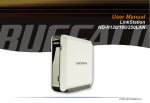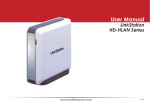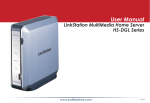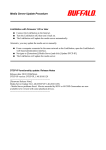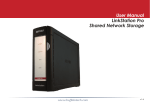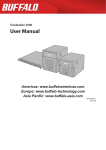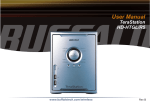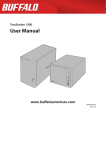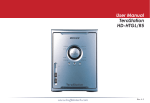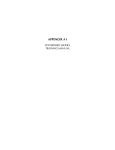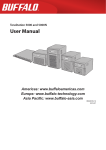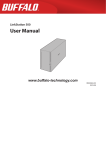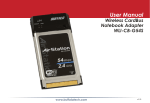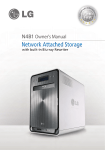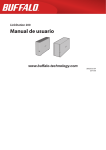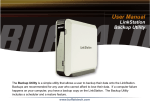Download User Manual
Transcript
User Manual LinkStation HD-H120/160/250LAN www.buffalotech.com/wireless Rev B Table of Contents Table of Contents LinkStation Diagram ......................................... 3 LinkStation Quick Setup ................................... 5 Link Navigator Setup ...................................... 11 Accessing LinkStation Data from PC ............. 20 LinkStation Expansion .................................... 23 Basic Settings ................................................. 24 Network Settings ............................................ 27 Security Settings ............................................ 31 USB Settings ................................................... 40 USB Printer Installation ................................. 44 Maintenance Settings ..................................... 48 Restoring Backups ......................................... 54 Troubleshooting .............................................. 59 Technical Specifications................................. 62 Technical Support ........................................... 63 FCC and GPL ................................................... 63 2 LinkStation Diagram 1. Power Button – The Power Button is used to power the LinkStation on or off. The power on process will take approximately 30 seconds to a full minute to complete. During this time, do not unplug the LinkStation from the wall outlet. To turn the LinkStation off, press and hold the power button for several seconds until the Power LED light begins blinking. At that time, stop pressing the button and shutdown should complete within 30 seconds. 2. Power LED – The Power LED light will blink during startup or shutdown, but otherwise will remain lit up while LinkStation is powered on. 3. LINK/ACT LED – The LINK/ACT LED light will light up if an Ethernet Cable is plugged in that is attached to another device such as a router, hub, or PC. Periodically, the LED will blink. This blinking signifies network activity. 3 LinkStation Diagram 4. Disk Full LED – When LinkStation’s internal drive approaches 95% of its capacity, the Disk Full LED will light up in red. For options to increase storage capacity, see ‘LinkStation Expansion’ section on Page 23. 5. Diagnostic LED – The Diagnostic LED may begin flashing when the LinkStation encounters an error. In this event, please contact our 24/7 technical support at 1(866) 752-6210. 6. USB Port (Front & Rear) – LinkStation offers two USB Ports for adding external drives or USB printers. Please see the ‘LinkStation Expansion’ section on Page 23 to learn more about how to take advantage of the USB Ports on LinkStation. 4 LinkStation Quick Setup The setup of the LinkStation is performed using the following steps: ◗ Plug the LinkStation’s power cord into a power outlet. 5 LinkStation Quick Setup ◗ Press the power button of the LinkStation to turn LinkStation on. Press the power button until the green Power LED begins to flash. 6 LinkStation Quick Setup ◗ Connect the included Ethernet Cable into the Ethernet port on the rear of LinkStation. Connect the other end of the cable into a hub, switch, or router on the network, or connect it directly to a nearby running PC. NOTE: It is recommended to connect LinkStation to a hub or switch on the network. Connecting it directly to the back of a PC should only be used if absolutely necessary. Many features including DHCP IP Addressing require LinkStation to be connected to a switch or hub. 7 LinkStation Quick Setup ◗ Check the LINK/ACT light on the front of the LinkStation. If it is lit, then your LinkStation is connected properly; please turn to Page 11 to continue setup. If it is not lit, continue to the next page. 8 LinkStation Quick Setup ◗ On the rear of the LinkStation, flip the black ‘Cable Selection’ switch. This switch tells LinkStation whether to communicate over a Crossover or Patch cable. ◗ Verify that the LINK/ACT LED on the front of LinkStation is lit (see Page 8’s picture). If it is lit, continue to Page 11 to continue setting up LinkStation. If the LINK/ACT LED is still not lit, please verify the following: 9 LinkStation Quick Setup ✓ Both LinkStation and the switch or PC are powered on. ✓ The Ethernet Cable is securely fastened to both devices. ✓ The Ethernet Cable is not damaged, to verify this try using another Ethernet Cable. ✓ When verifying new cables, remember to switch the ‘Cable Selection’ switch to both positions (see Page 9). If problems still persist, contact our 24/7 technical support at 1(866) 752-6210. 10 Link Navigator Setup The setup of the Link Navigator is performed using the following steps: ◗ Insert the Link Navigator CD into a PC’s CD-ROM drive. Depending on the PC’s configuration, the EasySetup program may launch. If it does not automatically launch, manually launch it by pressing the ‘Start’ menu, selecting the ‘Run...’ option. When the ‘Run’ dialog opens, type x: easysetup.exe (where x is the drive letter of the CD-ROM drive). Press ‘OK’ to continue. 11 Link Navigator Setup ◗ LinkNavigator is now running. Please press the ‘Install IP Setup Utility’ icon, then press the ‘Start’ button. The LinkStation IP Configuration Utility will launch and scan for networks. 12 Link Navigator Setup ◗ The IP Configuration Utility allows you to easily configure LinkStation’s network settings. The ‘Search’ button will re-scan the network for any and all LinkStations available. The drop down menu lists all available LinkStations. If there are multiple LinkStations on the network, then select the proper LinkStation from the pull down menu. Once the proper LinkStation has been selected, press the ‘Change IP Address’ button to continue. 13 Link Navigator Setup ◗ This part of the program changes LinkStation’s IP Address. Check the check box that states ‘Acquire IP Address Automatically’. This will give LinkStation an IP Address from the network’s router/DHCP server. A set (static) IP Address and Gateway can also be set if preferred. The ‘Administrator Password’ field sets an administrator password for the web-based configuration. If desired, type a password in the field. When finished, press the ‘OK’ button. LinkStation will set the IP Address and Password settings. NOTE: If LinkStation was plugged directly into a PC, then the DHCP function will timeout and give LinkStation the default IP Address of 192.168.11.150. You will need to adjust your PC’s IP Address to an IP Address on the same subnet (e.g. 192.168.11.151). 14 Link Navigator Setup ◗ LinkStation is now ready to be configured. The login prompt will appear. The user name is root. There is no password by default. If a password was specified on the previous step, then type that password in, otherwise leave the password field blank. Press the ‘OK’ button when finished. User name: root Password: There is no default password. Only enter a password if one was set on Page 14. ◗ In the future LinkStation can be accessed by typing http://LINKSTATION_NAME into a Web browser (where LINKSTATION_NAME is the name of LinkStation set on Page 17). 15 Link Navigator Setup ◗ Congratulations, you have logged into LinkStation. These are the main configuration menus. Please bookmark this page so it can be accessed for future configuration changes. For detailed explanations of each menu and setting, please refer to the ‘Settings’ section (starting on Page 24) of this manual. To continue setup, click on the ‘Basic’ link. This will allow you to setup some important settings. Then click on the ‘LinkStation Name Setup’ link to continue. 16 Link Navigator Setup ◗ This section allows you to change the name of your LinkStation. This name will be required to access LinkStation data. A friendly, easy name is recommended. Please enter an appropriate name in the ‘LinkStation Name’ field. Feel free to use your first or last name, a description of the content to be installed on LinkStation, or simply name it LinkStation. A short description of the LinkStation can be created in the ‘LinkStation Description’ field. This description will be shown while browsing through Network Neighborhood on Windows machines. Once the fields have been completed, press the ‘Apply’ button. 17 Link Navigator Setup ◗ By default there are two shared folders on LinkStation. One is for Windows and Mac machines, while the other is for Macs only. Windows machines will only see one share. If you would like to create additional shares for specific users or specific types of data, then click on the ‘Security’ tab on the left. Then click on the ‘Shared Folder Setup’ link to continue. From this screen you can add new shares/ folders or edit existing shares/folders. Press the ‘Add a New Folder’ button to begin creating a new share/folder. 18 Link Navigator Setup ◗ To begin setting up a new share, enter an appropriate share/folder name in the ‘Shared Folder Name’ field. Set the remaining settings to the desired function. ‘Access Restriction’ will turn on security features. Please refer to the ‘Settings’ section (starting on Page 24) of this manual before using the ‘Access Restriction’ function. Press the ‘Apply’ button when finished. A new shared folder has been setup. Please repeat this step to setup more shared folders. 19 Accessing LinkStation Data from a PC Accessing LinkStation data is performed using the following steps: ◗ Press the ‘Start’ menu, select the ‘Run...’ option. When the ‘Run’ dialog opens, type \\LinkStation_Name (where LinkStation_Name is name of the LinkStation set on Page 17). Press the ‘OK’ button to continue. 20 Accessing LinkStation Data from a PC ◗ LinkStation’s root directory will appear. You will see all of the configured shares. All users can read and write to all folders unless otherwise configured. To setup security and password protection, please refer to the ‘Settings’ section (starting on Page 24) of this manual. To setup a printer see the ‘LinkStation Expansion’ section found on Page 23. LinkStation can be accessed by multiple PC’s simultaneously by following this step. A drive letter can also be mapped for LinkStation, see the next page for more information. 21 Accessing LinkStation Data from a PC ◗ From the previous step’s ‘Root Directory’ screen, use the pull down menu and click ‘Tools’ and then select ‘Map Network Drive’. The ‘Map Network Drive’ program will run. Select the drive letter you would like LinkStation to assume from the ‘Drive:’ pull down menu. Enter the \\LinkStation_Name\ share_name in the ‘Folder:’ field (where LinkStation_Name is the ‘LinkStation Name’ set on Page 17 and share_name is the ‘Shared Folder Name’ set on Page 19). You can also browse for the shared folder by pressing the ‘Browse’ button and searching through the ‘Entire Network’ and then the ‘Microsoft Windows Network’. Once complete, press the ‘Finish’ button. LinkStation is now mapped to a drive letter. NOTE: If errors occur while mapping multiple drive shares, please see Page 58 for help. 22 LinkStation Expansion LinkStation Expansion Information LinkStation has two USB 2.0 ports on it. These ports can be used for adding an external USB Hard Drive or a USB Printer. LinkStation will then share the USB device to everyone on the network. There is one port on the front of LinkStation and one port on the back of LinkStation. One printer and one external USB Hard Drive can be added to either of the ports. However, two USB Printers or two USB Hard Drives cannot be added, only one of each device. To connect a USB device to LinkStation, simply plug it into one of the USB Ports and set it up in the LinkStation configuration. NOTE: A USB printer can be added to either of the two USB Ports, but a USB Hard Drive MUST be added to the rear USB Port. Thus, if you have a USB printer and a USB Hard Drive, the printer must be plugged into the front USB Port. USB Hard Drive Information: See Page 42 to show you how to enable a USB Hard Drive to be used for shared folders. Page 55 will show you how to format the USB Hard Drive. Page 52 & Page 53 will show you how to setup LinkStation to backup to a USB Hard Drive. USB Printer Information: See Page 43 to setup a USB Printer on LinkStation. 23 Basic Settings This section explains the functions of LinkStation’s settings: Basic Setup LinkStation Name Setup: LinkStation should be configured with a unique name to identify it over the network. A general description can be given for the device as well. Date and Time Setup: To properly catalogue shares and files by date, and to properly schedule tasks (such as backups), the current date and time must be set. An NTP client is configurable for automatic time corrections. 24 Basic Settings LinkStation Name Settings LinkStation Name: The LinkStation name is a very critical piece of information. This name is used to access LinkStation and is a key element in differentiating LinkStation from other computers and devices on the network. The LinkStation name should be something easy to remember. It can be named after its owner, it’s location, or the type of data that will be installed on it. If there is only one LinkStation on the network, then naming it ‘LinkStation’ would be fine. LinkStation Description: The LinkStation Description is a handy way of differentiating multiple LinkStations. A suitable description would be a short sentence or phrase describing LinkStation’s purpose. The description will appear when browsing through Network Neighborhood. The ‘Apply’ button will set the settings. 25 Basic Settings LinkStation Time and Date Setup Time Setup: The LinkStation time must be set to maintain proper logs and to schedule proper backups Input the proper time and date or press the ‘Get Current Date & Time’ button to set LinkStation’s time to the same time as the PC that is being used to configure it. The time may need to be changed at a later time to accommodate daylight savings changes. Select the appropriate region from the ‘Character Code’ pull down menu. This specifies and/or activates LinkStation’s use of International Character Support. NTP Settings: The NTP function enables the LinkStation to poll a network time server to correct its time. Once enabled, an IP Address of a NTP Server is required. A domain name will not work in this field, an IP Address is required. Buffalo recommends use of (time.nist.gov) 192.43.244.18 as an Internet NTP Server. The Sychronized Interval is the setting that states how often the check takes place. The ‘Apply’ buttons will set the settings for their respective sections. 26 Network Settings IP Address Settings: By default, LinkStation will attempt to obtain an IP Address from a DHCP Server. If a DHCP Server is not available, it will assign itself an IP Address of 192.168.11.150. A designated static IP Address can be given to LinkStation within ‘IP Address Settings’. The gateway and subnet can also be set here. FTP Server Settings: LinkStation includes a built-in FTP Server. The FTP Server can be used for accessing files over the internet using the popular FTP protocol. All of the FTP Server related settings can be accessed from the ‘FTP Server Settings’. 27 Workgroup/Domain Settings: If a Microsoft Workgroup or Domain needs to be setup for the LinkStation, it can be performed in the ‘Workgroup/Domain Settings’. WINS server information can be added as well, but is not necessary in most environments. Network Settings LinkStation IP Address/Gateway Settings IP Address Settings: LinkStation operates using the TCP/IP protocol. Thus, it must have an IP Address to communicate on a network. This IP Address is also used to access the web-based configuration menus. By default LinkStation will attempt to gain an IP Address from a DHCP server. If it cannot obtain an IP, it will default to the IP Address 192.168.11.150 . Contact your administrator to determine a proper IP Address and Subnet mask for this device. 255.255.255.0 is the recommended default Subnet mask. It is recommended for most users to use DHCP unless they have a thorough understanding of their network. Default Gateway Setup: By default LinkStation does not require a default gateway address. If DHCP is enabled, then the Gateway will be setup automatically. If DHCP is not used, then please contact your Network Admin for the proper Gateway information. Gateway setup is required for some features to work properly (e.g. NTP, FTP, Remote Web-Based Configuration, etc.) 28 Network Settings LinkStation Microsoft Networking Settings Microsoft Networking: Please select the appropriate Network ID. Workgroup is recommended for most home and small business applications. If Workgroup is chosen, then enter the proper workgroup in the ‘Workgroup Name’ field. Domain is used for business applications that operate on a Windows Domain. If Domain is chosen, enter the proper Domain Name and PDC Host name in their respective fields. If the LinkStation is connected to a Domain, then it will acquire the user list from the primary domain controller. If LinkStation is connected to a Workgroup, then it will rely on its internal users and groups. Wins Client Settings: By default LinkStation does not require a WINS Server address. It is recommended to not use one unless specified by a network administrator. 29 Network Settings LinkStation FTP Server Settings FTP Server: To enable LinkStation’s FTP Server, set the FTP Server to ‘Enable’. It is not recommended to enable the FTP Server unless you are familiar with how FTP works. Please contact our 24x7 technical support for more information regarding FTP. FTP Access User is the setting that specifies if the FTP Server is anonymous or password protected. Select ‘Registered Users’ for a password protected FTP Server. If ‘Anonymous’ is selected as the FTP type, then one and only one shared folder on LinkStation can be made available; select that folder as the ‘Anonymous User Shared Folder’. ‘FTP Access’ specifies whether the anonymous shared folder is read only or writable, select the appropriate setting. If ‘Registered Users’ is selected as the FTP type, then the shared folders that are to be added to the FTP Server must be checked. Check the appropriate checkboxes under ‘Registered Users Public Shared Folder Settings’. Multiple shared folders can be added when the ‘Registered Users’ FTP is used. The shared folder’s settings are carried over from LinkStation to the FTP Server. A user account that has been added to LinkStation can be used for FTP login credentials. Different user accounts have different access restrictions, their rights will carry over as rights on the FTP Server. 30 Security Settings Setup Shared Folder Shared Folder Setup: Shared folders should be created to store data. Access to shared folders can be controlled via group and User permissions. By default a shared folder will allow access to all groups and users. Folders can be created in file formats for use by Windows, Mac, or both operating systems. Group Setup: To ease security administration, groups should be created for users to control shared folder access. Once a group has been created, settings on shared folders can be modified to limit access to a group or groups. Also, individual users can be added to the groups. 31 User Setup: Individual users and passwords should be created for each user that needs to access restricted shared folders. Once created, a user can specifically be given access to a shared folder or included in a group. Domain User List: A Domain User List is available when LinkStation is a member of a Domain. This list displays the user list obtained from the PDC. Security Settings LinkStation Shared Folder Setup LinkStation stores its data in shares. Multiple shares can be configured for different types of data. By default LinkStation has two shares. One share is for Windows and Macintosh computers. The other share is for Macintosh only. The default shares CAN be deleted if desired. Add a New Folder: This begins the process to create a new share. The next page describes this process further. Edit Shared Folder: This button allows shared folder information to be edited. Delete Shared Folder: This button deletes a shared folder. CAUTION: This will delete all of the data inside of the shared folder. 32 Security Settings LinkStation New Shared Folder Settings Adding a new shared folder will create a new shared folder on LinkStation to store data. Shared Folder Name: This name will be the name of the shared folder on LinkStation. Shared Folder Description: The shared folder description should be used to differentiate the folders on LinkStation. A brief sentence or phrase regarding the specific data in the share is recommended. Shared Folders OS Support: Select the proper option for the folder. If only Windows machines will access this shared folder, then select ‘Win’. If both Windows and Macintosh machines will access this shared folder then select ‘Win/Mac’. Finally, if only Macintosh machines are to access this shared folder, then select ‘Mac’. For compatibility ‘Win/Mac’ is recommended. Access Restriction Function: This function turns on user/group permissions. Using this function will password protect a folder. For more information, see the next page about using ‘Access Restriction’. Recycle Bin: The recycle bin is a feature that moves deleted data to a recycle bin first. If the recycle bin is disabled, then any deleted data inside the shared folder cannot be restored. If the recycle bin is enabled, then all data will be moved to a folder called, ‘.trash’. Data will then need to be removed from the trash before it is permanently deleted. In Windows it may be necessary to set Windows to display all hidden files and folders before the .trash folder is visible. Consult your OS documentation for more information. Mac OS 10.2 or higher is required for Recycle Bin functionality in Mac environments. 33 Security Settings LinkStation Shared Folder Setup - Access Restriction Settings On the previous page, there is an ‘Access Restriction’ function. By enabling it, the new shared folder will be restricted to a selected amount of users and/or groups. When ‘Access Restriction’ is set to ‘Enable’ the ‘Apply’ button will turn into a ‘Next’ button. This signifies that there is one more step to complete before the new shared folder can be setup. Press the ‘Next’ button to continue.You will then be prompted with the ‘Access Restriction Settings’ page. NOTE: This same information applies when an existing shared folder is modified by pressing the ‘Edit Shared Folder’ button on the main ‘Shared Folder Settings’ page and enabling ‘Access Restriction’. Here you can specify who accesses the new shared folder. Then select which groups and which users will have access to the new shared folder. The group ‘hdusers’ gives access to all users on the LinkStation, so this will allow access to every user on the LinkStation. Anonymous users will not have access however. If a group is selected, then every member inside that group will have access to the shared folder. For example, in the image above, Group1 (which includes Bob and Jane) is selected. The user Richard is also selected. This means that Bob, Jane, and Richard will be the only users who will have access to this shared folder. Press the ‘Apply’ button when you’re finished making your selections. 34 Security Settings LinkStation User Group Settings Groups allow for quicker security administration. A group is a group of users with specific rights to specific shared folders. A business may want to make a ‘Manager’ group and add all of its managers to the group. This group could have access to a shared folder that the regular employees do not have access to. By default there is a share called ‘hdusers’. This share cannot be deleted. Add New Group: This begins the process to create a new group. Edit Group: This allows group settings to be changed. Users can be added or removed from the group here. Delete a group: This button deletes a group. The users inside the group will still exist but will no longer be a member of the deleted group. 35 Security Settings LinkStation User Group Setup - Add New Group Group Name: This will be the name of the group. The name should somehow reflect the types of users added. For instance, the manger’s group could be named, ‘Managers’. Group Description: The group description should be used to differentiate the different groups on LinkStation. A brief sentence or phrase regarding the users inside of the group is recommended. Select Affiliated Users: Select the users that are to be added to this new group. The check box next to the user’s name should be checked if they are to be added to the group. Users can be added or removed to the group at a later time by editing the group and checking or unchecking their respective box. The ‘Apply’ button will set the settings. 36 Security Settings LinkStation User Settings User accounts allow LinkStation to limit access to certain or all shared folders. A user account is assigned a password. This password is used to obtain the data inside the shared folder. If a user does not have the proper user account credentials, then access to the data will be denied. NOTE: User accounts will only be used on shares with the ‘Access Restriction’ function turned on. Add New User: This begins the process to create a new user. Edit User Info: This allows user information to be changed. The user password can also be changed here. Delete User: This button deletes a user. If a user is deleted, it will be removed from any groups it was associated with as well. 37 Security Settings LinkStation User Setup - Add New User User Name: This will be the name of the user. The name should somehow reflect the user added. For instance, the user’s first name. Password: The user password is the password associated with the user. The password can be up to 8 characters and can contain spaces, hyphens, and underscores. The password will need to be confirmed on the ‘Password(Confirm)’ line as well. The password can be changed at a later time by editing the user’s settings. User Description: The user description will help to differentiate different users on LinkStation. The ‘Apply’ button will set the settings. 38 Security Settings LinkStation Domain User List The Domain User List is a list of users obtained from the Primary Domain Controller on a Windows Domain Network. To setup LinkStation Domain settings, please refer to the settings on Page 29. Using LinkStation on a Domain offers the flexibility to use the users from a Windows Domain, as opposed to adding each user separately. 39 USB Settings USB Setup USB Details: All devices currently connected to the LinkStation will be displayed under ‘USB Details’. It may be necessary to restart the LinkStation when new USB devices are attached to the LinkStation. USB Disk Setup: An attached USB Disk can be configured as an additional shared folder for additional storage space. The attached USB Disk must be formatted by the LinkStation before it can be used on LinkStation. If a USB Disk is attached to LinkStation, it must be attached to the rear USB Port. Clear Printer Job Queue: If the printer queue on the LinkStation becomes corrupt, the print queue should be cleared. All submitted print jobs will need to be re-sent to the printer. 40 USB Printer Setup: Postscript Printers can easily be shared from the LinkStation via USB. If a non-Postscript Printer is attached, additional information from your printer’s documentation is required in the LinkStation printer setup to ensure proper operation. Once installed, the printer will be available to users on LinkStation. USB Settings LinkStation USB Setup - USB Information USB Information: The USB Information table lists information about connected USB devices (such as printers and hard drives). It lists the USB Class (Printer or Storage), the Manufacturer if available, the Device Name, and whether it is a USB 1.1 or USB 2.0 device. 41 USB Settings LinkStation USB Setup - Setup USB Disk Setup USB Disk: The USB Disk setup options specifies if an attached USB Disk is to be used as a shared folder. Using it as a shared folder increases the capacity of LinkStation. Selecting the ‘Disable’ option makes it impossible to make the USB Disk drive a shared folder. However, if set to ‘Disable’, the USB Disk will still be available for Disk Backup. NOTE: The USB Disk must be attached to the rear USB Port to work properly. The front USB Port only works with USB Printers. Recycle Bin: The recycle bin is a feature that moves deleted data to a recycle bin first. If the recycle bin is disabled, then any deleted data inside the USB Disk cannot be restored. If the recycle bin is enabled, then all data will be moved to a folder called, ‘.trash’ on the USB Disk. Data will then need to be removed from the trash before it is permanently deleted. In Windows it may be necessary to set Windows to display all hidden files and folders before the .trash folder is visible. Consult your OS documentation for more information. Mac OS 10.2 or higher is required for Recycle Bin functionality in Mac environments. 42 USB Settings LinkStation USB Setup - Print Server Print Server: The Print Server function quickly turns sharing of the printer on or off. The Print Server function has to be set to ‘Enable’ if a printer is to be shared. By default LinkStation is configured to share a PostScript printer. Most modern USB printers are PostScript printers. In this case all of the settings are automatically set. If a non-PostScript printer is connected to LinkStation, then select a compatible printer from the ‘Printer Type’ pull down menu. Other settings will have to be set based on the printer’s documentation. The ‘Apply’ button will set the settings. For the printer to work on your network, it must be plugged into one of LinkStation’s USB Ports, and the printer must be powered on. It may be required to turn off LinkStation and turn it back on after connecting the USB printer to one of the USB Ports. Please see Page 44 for information on installing the printer to Windows PC’s on your network. 43 USB Settings LinkStation USB Setup - Printer Share Installation Printer Share Installation: Now that LinkStation is setup to share your printer, you can easily add the printer to any Windows PC on your network. Please see the following steps for the installation procedure. ◗ Access the LinkStation by pressing the Start Menu, selecting the ‘Run...’ option and entering \\LinkStation_Name (where LinkStation_Name is the name set on Page 17). Press the ‘OK’ button when finished. ◗ Right click on the ‘lp’ icon and select ‘Connect’. You may receive a warning about installing from a trust worthy source. If you receive this message, press the ‘Yes’ button to continue. NOTE: The LinkStation’s Printer name cannot be changed from LP. LP stands for LinkStation Printer ◗ You will receive a warning stating that the server does not have the proper drivers. Press the ‘OK’ button to continue. 44 USB Settings LinkStation USB Setup - Printer Share Installation (continued) ◗ The ‘Add Printer Wizard’ will launch. Select the proper driver for your printer. If the specific printer is not in the list, you will be required to insert the CD that came with your printer into your PC’s CD-ROM drive and press the ‘Have Disk’ button. Please refer to your printer documentation for more clarification. Press the ‘OK’ button when finished. ◗ The printer is now successfully installed. To further configure and test the printer, open your PC’s Control Panel. The Control Panel can be accessed through ‘My Computer’ or through the Start Menu. Once the Control Panel is open, double click on the ‘Printers and Faxes’ icon. ◗ If this is the only printer installed on the PC, then it will automatically be set as the default printer. However, if it is not the only printer on the PC then it is not set as default. If you would like to make it default, right click on the ‘lp’ printer icon and select the ‘Set as Default Printer’ option. 45 USB Settings LinkStation USB Setup - Printer Share Installation (continued) ◗ To print a test page or configure additional printer settings, right click on the ‘lp’ printer icon and select ‘Properties’. This will open the printer’s driver properties. ◗ Press the ‘Print Test Page’ button to print a test page. You can also browse through the available settings for the printer. Please refer to the printer’s documentation for more info on changing the printer’s settings. NOTE: The printer installation process can be done on any machine on your network. Mutliple machines may print to the printer at the same time. Please repeat this process on all computers that require access to the printer. 46 USB Settings LinkStation USB Setup - Delete Print Queue Deleting the print job(s) may be necessary if a corrupt print job was sent to a printer. If printing to the printer connected to LinkStation suddenly fails, it is recommended to ‘Execute’ the ‘Delete Print Queue’ program. Deleting the print job(s) will require users to re-send their print jobs to the printer. If there are still problems printing to the printer, then check the printer manufacturer’s documentation for troubleshooting information. Also, verify that the USB cable is securely fastened to both the printer and the LinkStation. Finally, you may try turning the LinkStation off, turning the printer off, turning the printer back on, and then turning the LinkStation back on again. 47 Maintenance Settings Maintenance Disk Backup: Individual Shares or folders inside of shares can be scheduled for backup to an attached USB Disk. The scheduled backup time should not conflict with a scheduled sleep time. Disk Scan: Periodically it may be necessary to run a disk scan. A disk scan will repair errors upon the LinkStation’s drives’ surfaces and fix errors within the file system. A thorough disk check can take several hours to complete. System Status: The System Status page displays current information about LinkStation. Disk Sleep Function: The LinkStation can be scheduled to enter a sleep mode to preserve energy at a scheduled time. The sleep time cannot coincide with the time of a scheduled backup or the backup will fail. 48 Maintenance Settings Maintenance Administrator Password: By default, the administrator name (login) is root with a blank password. ‘Administrator Password’ allows you to setup or change the administrator password. Shutdown: Shutdown allows an administrator to turn off the LinkStation without physically pressing the power button. Disk Format: The internal drive or an attached USB drive can be formatted and rebuilt. Once a format begins all data will be lost on the drive. Care should be taken to backup any data stored on the drive prior to formatting. Any external USB Disks attached to LinkStation will need to be formatted via this Disk Format utility before being used by LinkStation. 49 Maintenance Settings LinkStation System Status System Status: The ‘System Status’ page briefly lists important configuration information about LinkStation. No settings can be changed from this screen, but it’s a good place to review settings. 50 Maintenance Settings LinkStation Disk Sleep Setup Sleep Function: The ‘Sleep Function’ turns on the ability to put LinkStation into sleep mode for a period of time. LinkStation’s internal hard drive shuts off until the ‘Wakeup Time’. The ‘Disable’ option disables the ‘Sleep Function’. Select ‘Disable’ if you want LinkStation to always remain on. When LinkStation is sleeping, data cannot be accessed and scheduled backups will fail. Sleep Conditions: If the ‘Sleep Function’ is set to ‘Enable’, then enter an appropriate ‘Disk Sleep Time’ and ‘Disk Wake Up Time’. The ‘Apply’ button will set the settings. 51 Maintenance Settings LinkStation Backup Settings All Disk Backups are sent to the attached USB Disk on LinkStation. Please skip to Page 54 on how to restore Backups. Disk Backup Folders: Before Disk Backup can be enabled, at least one share or folder inside of a share must be added to the Backup. To select a share or folder to be backed up, use the drop down menu under ‘Folders for Backup’. It is important to note that all files and folders underneath the share or folder (recursive) selected will also be backed up. Once a share or folder is selected, press the ‘Backup Folder Add’ button to add it as a backup source. To remove shares or folders as backup sources, check the checkbox next to the share(s) or folder(s) and press the ‘Backup Folder Delete’ button. Multiple shares or folders can be deleted simultaneously by checking more then one share or folder. The next page goes through the remainder of the Backup Settings. Once completed, press the ‘Apply’ button to set the settings into memory and begin the Backup Scheduler. 52 Maintenance Settings LinkStation Backup Settings Disk Backup: The ‘Disk Backup’ function allows LinkStation’s data to be backed up to an external USB Hard Drive. Backing up data is important in the event of LinkStation becoming damaged. Without a backup you risk losing data if a catastrophe happens. The ‘Disable’ option turns off the ability to backup. Backup Frequency: There are three options for starting backups. The ‘Run Backup Immediately’ option makes LinkStation begin backing up instantly. This is a one-time backup solution. The ‘Run Backup Daily at the Specified Time’ option makes LinkStation perform backups daily at a scheduled time. The ‘Run Backup Every (DAY) at the Specified Time’ option makes LinkStation perform a backup at a scheduled time only once a week. Specified Time: The ‘Specified Time’ is the time that LinkStation will perform it’s backup if scheduled. Overwrite Backup: The ‘Overwrite Backup’ option specifies whether LinkStation will create a new backup everytime or whether it will overwrite every backup. If ‘Overwrite Backup’ is set to ‘Disable’ then a new folder will be created on the USB Disk everytime a backup occurs If it is set to ‘Enable’ then there will be only one backup on the USB Disk and it will continually be overwritten. 53 Restoring a Backup Disk Backup - Restoring a Backup ◗ To restore a backup, the USB Disk must be shared as a shared folder. This setting can be enabled on Page 42. Then, browse to LinkStation and find the folder labeled ‘usbdisk1’. This is where all of the backup data is sent during backups. Double click on its icon, or right click on it and select the ‘Open’ option. ◗ Once inside of the folder, the backup archives will be present. If there are multiple folders labeled by numbers, then multiple backups exist on the USB Disk. You will need to select the proper backup before accessing the data. The backup naming convention in this case is (YEARMONTHDAYTIME). Thus, 0408062200 is a backup that occured on August 6th, 2004 at 22:00 (or 10pm). If ‘Overwrite Backup’ was set when the backup ran, then only one backup folder will exist. Also, if the USB Disk has been used as additional storage, then other files and folders may exist. From inside the backup archive, data can be moved or copied to its original location. It can also be placed in a new location. NOTE: LinkStation backup USB Disks can be added to other LinkStations to recover the data in the event that a LinkStation fails. In this case, just attach the USB Disk to another LinkStation, share it as a shared folder, and access the data as described above. DO NOT REFORMAT the USB Disk when adding it to another LinkStation; this process will delete all of that data on the USB Disk.. 54 Maintenance Settings LinkStation Disk Scan Disk Scan: The ‘Disk Scan Target’ is the disk that is to be scanned. The ‘Internal HDD’ option is for LinkStation’s internal hard drive. If a USB Hard Drive is connected to LinkStation, then it will be available from the pull-down menu. Please select the disk that should be scanned. If both disks are to be scanned, then the ‘Disk Scan’ must be run twice; once for each disk. Disk Scan Type: The ‘Disk Scan Type’ pull-down menu allows you to select whether the ‘Disk Scan’ is to be a ‘Normal’ or a ‘Thorough’ scan. A normal scan will perform a fast disk scan. The ‘Thorough Scan’ will scan every sector individually. The ‘Thorough Scan’ can take up to several hours to complete. It is recommended to not access LinkStation or turn LinkStation off during a ‘Thorough Scan’. 55 Maintenance Settings LinkStation Format Select a disk to format: The pull-down menu lists the drives that can be formatted. If a USB Hard Drive is connected to LinkStation then it will be available for format. The ‘Internal HDD’ can also be formatted from this page. All external USB Hard Drives MUST be formatted by LinkStation before they are used. NOTE: Formatting a drive will erase all data. Do not format a drive unless you are absolutely sure you want to delete ALL of the data on the drive. Brand new USB Disks will need to be formatted, but the internal LinkStation hard drive comes pre-formatted. Before formatting a USB Disk, please make sure it is plugged into the rear USB Port on LinkStation. Only the rear USB Port supports use with a USB Disk. 56 Maintenance Settings LinkStation Administrator Password Settings Administrator Name: The ‘Administrator Name’ is used to log into the Web-Based configuration. The default ‘Administrator Name’ is root. It cannot be changed. Old Password: Please type the current administrator password into this field. By default there is no LinkStation password. If a password has already been set on LinkStation, then enter the current password. New Password: Please enter the new desired administrator password. This password can be up to 8 characters and CAN use spaces, hyphens, and underscores. New Password(Confirm): Please re-type the ‘New Password’ into this field. This will verify that the proper password was typed in correctly. 57 Maintenance Settings LinkStation Shutdown Shutdown: The ‘Shutdown’ function in LinkStation allows an administrator to shut down LinkStation without using the power button. This feature can be handy if LinkStation is being configured over the Internet, or from a location not close to the LinkStation’s power button. Press the ‘Execute’ button to shutdown the LinkStation. The LinkStation can only be turned on by pressing the power button on the front of it or by waiting for the Wake Up Time (if set on Page 51). 58 Troubleshooting - Multiple Shares ◗ When adding multiple shares, it’s possible that you may get an error message similar to the following: This is caused by having multiple shares to the same resource using different credentials. The error occurs when connecting to at least one secure, restricted share. Due to a constraint in Microsoft Windows only one set of credentials can map drive letters for a network resource (LinkStation). Thus, only one username and password can be used while mapping a drive. If unsecure, unrestricted shares are mapped, and then an attempt to map a secure, restricted share occurs, then this error will occur. To remedy the situation, you must create the mapped shares using the same login and password information. Please follow the steps on the next page to remedy this problem. 59 Troubleshooting - Multiple Shares ◗ When mapping any share, select the ‘Connect using a different user name’ option. A login and password prompt will appear. Enter the same username and password for all shares. This username and password is the username and password required for the secure, restricted share. Use this same login procedure for all unsecure, unrestricted and restricted shares on LinkStation. Due to this limitation, only one username and password can be used for all mapped shares. Thus, a PC cannot have two mapped, secured shares that use different username and passwords. It is important to remember that ALL mapped drives must use the same username and password. This means that even unsecure, unrestricted mapped shares will have to login using the secured share’s username and password. If only unrestricted shares are being mapped, then it is not necessary to set a username and password for the shares. Multiple mapped drives to unrestricted shares can exist without a username and password (as long as no restricted, secure shares are mapped). 60 Troubleshooting - Multiple Shares ◗ If LinkStation encounters a disk error, it will be reported in the LinkStation status on the top of any of the Web-Based configuration screens. It is recommended to start a ‘Normal’ Disk Scan in the event of this error. If that does not work, try running a ‘Thorough’ Disk Scan. Additionally, if that still does not resolve the problem a format is recommended. Formatting the drive will delete all of the data on it so try to backup any data you can before this process is started. Finally, if none of the above solutions help, then please contact our 24x7 Technical Support at 1(866)-752-6210 for more assistance. 61 Technical Specifications LAN Standards: IEEE 802.3u 100BASE-TX; IEEE 802.3 10BASE-T Transmission Types: 100Mbps/10Mbps; 100BASE-TX 4B/5B, MLT-3;10BASE-T Manchester Coding Access Media: CSMA/CD Media Interface: RJ-45 USB Standard: USB 2.0 Hi-Speed (HS) Full-Speed (FS) Low-Speed (LS) USB Connector: USB A Connector (2) Data Transmission Speed: Max: 480 Mbps (HS Mode) Max: 12 Mbps (FS Mode) Electric Current: 5.0V Power Consumption: 17W Maximum Dimensions: 2.4 x 6.94 x 7.4 in. (60 x 173.5 x 185 mm.) Weight: 3.8 LB. (1.3 kg.) Operating Temperature: 5-35 C; 20-80% non-condensing 62 Technical Support Buffalo Technology offers toll-free technical support 24 hours a day, 7 days a week for this product. Customers in the United States and Canada can obtain technical support using the following information: Web: E-mail: Telephone: www.buffalotech.com [email protected] 1(866)-752-6210 (USA & Canada only) FCC Warning This device complies with part 15 of the FCC Rules. Operation is subject to the following two conditions: (1) This device may not cause harmful interference, and (2) this device must accept any interference received, including interference that may cause undesired operation. GPL Statement This product uses GPL/LGPL software. Please see the GNU LICENSE document on the LinkNavigator CD-ROM for more information concerning the terms of the license. To obtain a copy of our open source software, please send a message to [email protected] to inquire about obtaining a package. 63































































